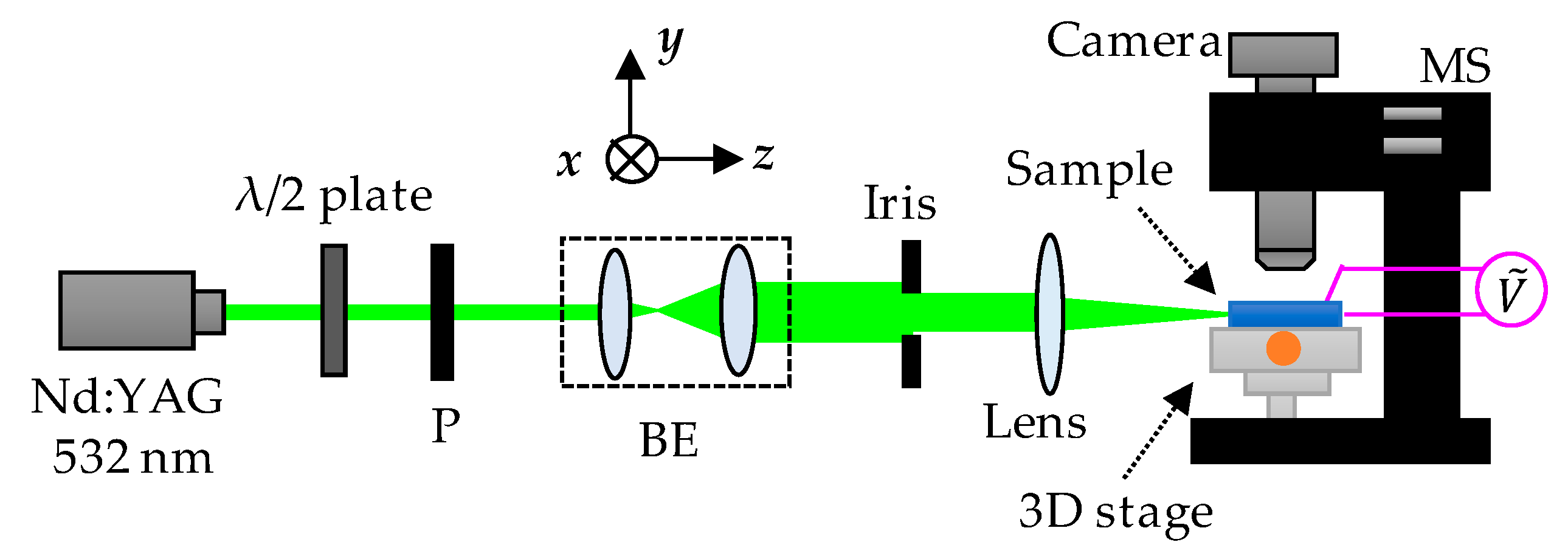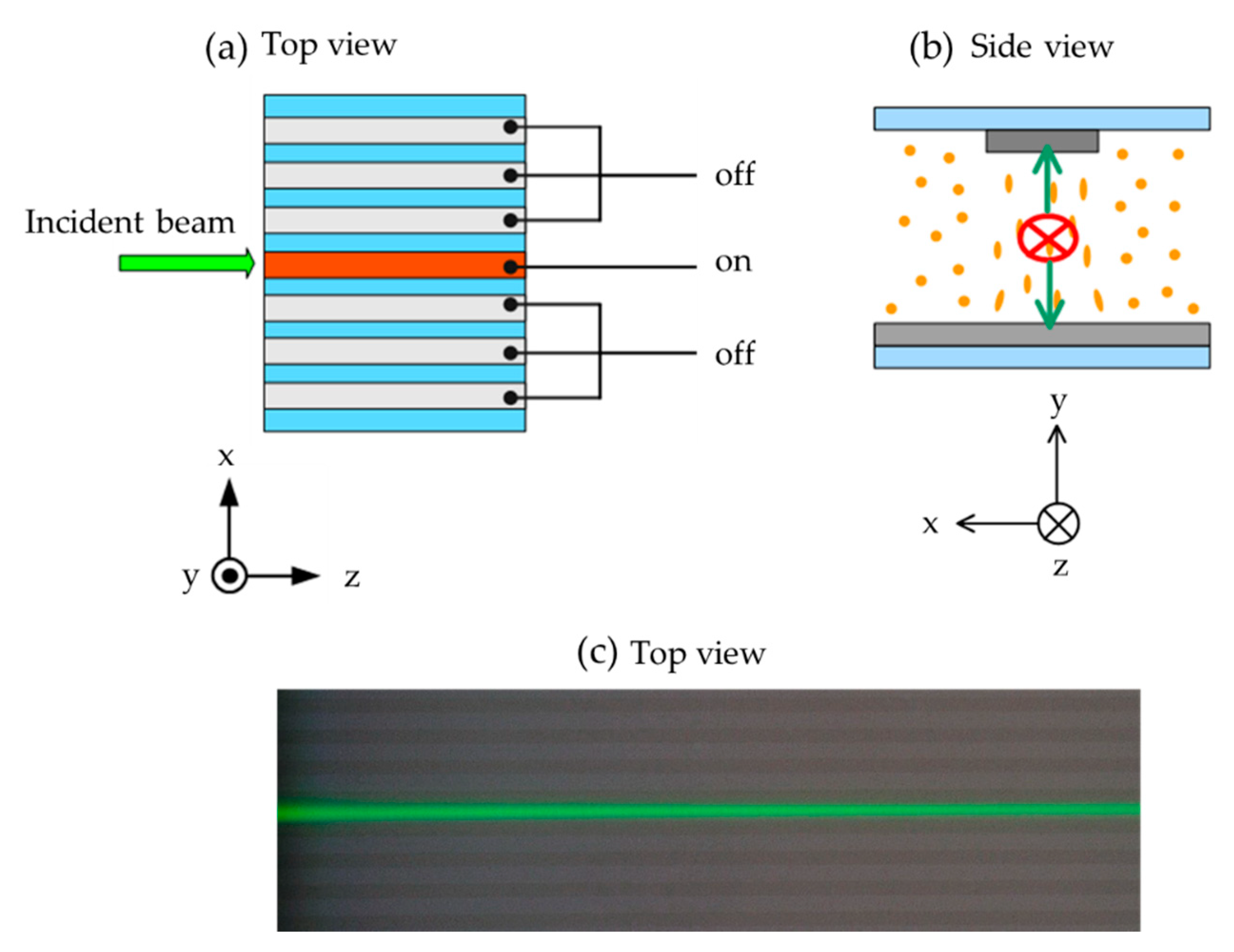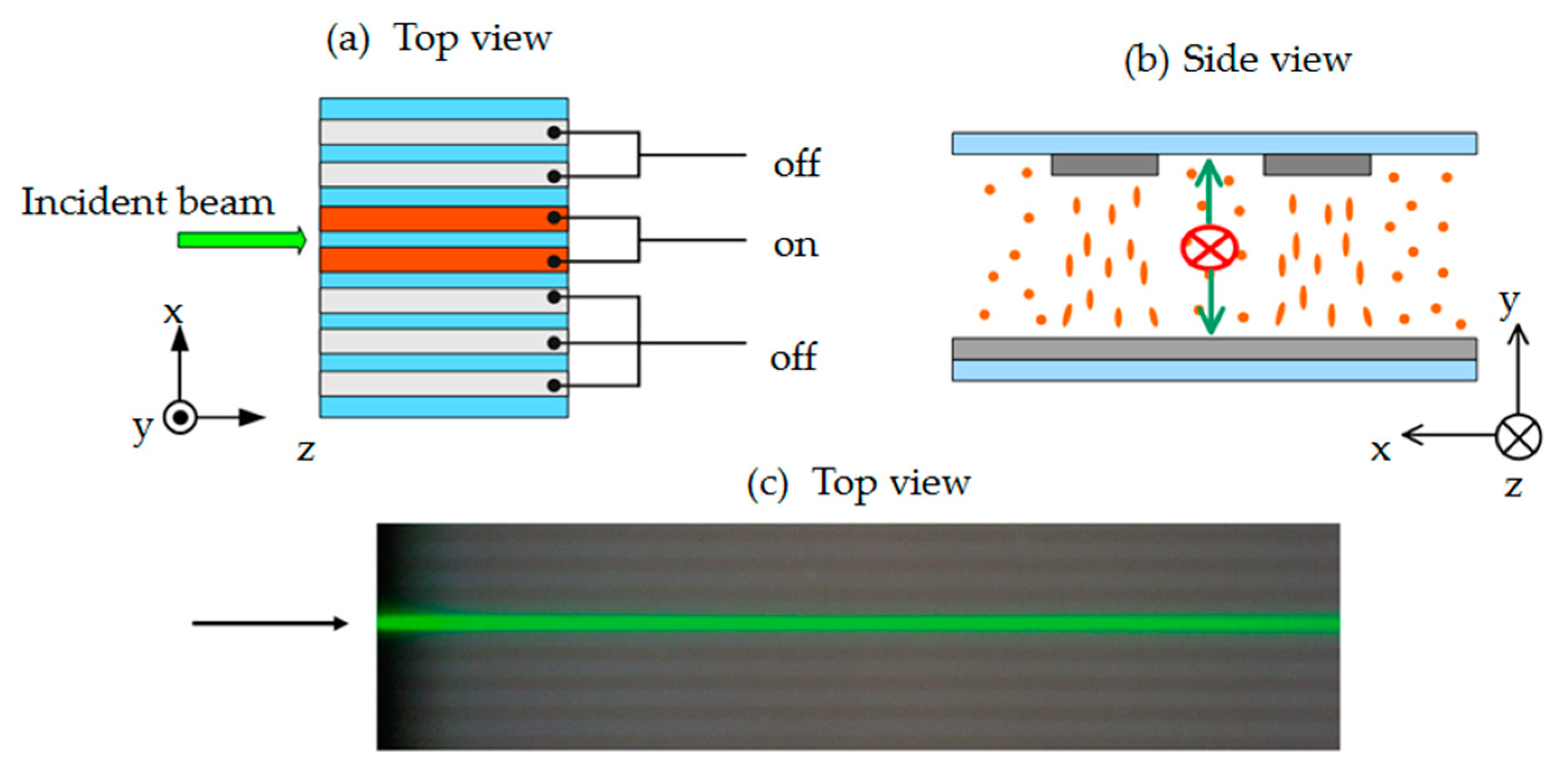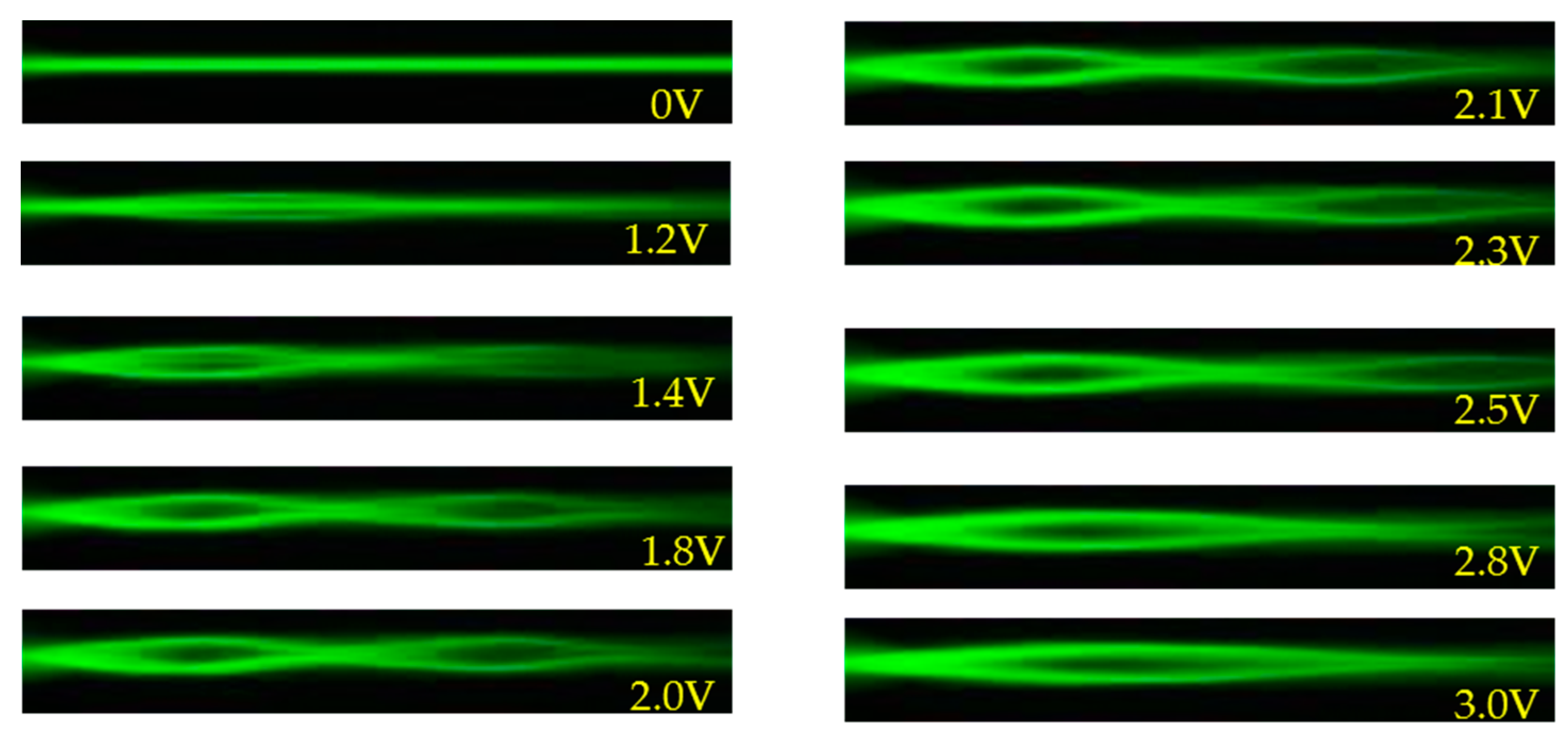Electrically Controlled Self-Focusing and Self-Localization in the Guided Channels
Abstract
:1. Introduction
2. Materials and Methods
3. Results and Discussion
4. Conclusions
Author Contributions
Funding
Conflicts of Interest
References
- Curtis, J.E.; Koss, B.A.; Grier, D.G. Dynamic holographic optical tweezers. Opt. Commun. 2002, 207, 169. [Google Scholar] [CrossRef]
- Terris, B.D.; Mamin, H.J.; Rugar, D. Near-field optical data storage using a solid immersion lens. Appl. Phys. Lett. 1994, 65, 388. [Google Scholar] [CrossRef]
- Armstrong, J. OFDM for optical communications. J. Lightwave Technol. 2009, 27, 189. [Google Scholar] [CrossRef]
- Takeda, H.; Yoshino, K. Tunable light propagation in Y-shaped waveguides in two-dimensional photonic crystals utilizing liquid crystals as linear defects. Phys. Rev. B 2003, 67, 073106. [Google Scholar] [CrossRef]
- Tsai, M.S.; Kuo, C.T.; Huang, S.Y.; Shih, C.C.; Jiang, I.M. Voltage-controlled multiguide directional coupler formed in a planar nematic liquid crystal film. Appl. Phys. Lett. 2004, 85, 855. [Google Scholar] [CrossRef]
- Asquini, R.; Fratalocchi, A.; d’Alessandro, A.; Assanto, G. Electro-optic routing in a nematic liquid-crystal waveguide. Appl. Opt. 2005, 44, 4136. [Google Scholar] [CrossRef]
- Fratalocchi, A.; Assanto, G.; Brzdakiewicz, K.A.; Karpierz, M.A. All-optical switching and beam steering in tunable waveguide arrays. Appl. Phys. Lett. 2005, 86, 051112. [Google Scholar] [CrossRef]
- Fratalocchi, A.; Assanto, G. All-optical switching in a liquid crystalline waveguide. Appl. Phys. Lett. 2005, 86, 051109. [Google Scholar] [CrossRef]
- Hutsebaut, X.; Cambournac, C.; Haelterman, M.; Beeckman, J.; Neyts, K. Measurement of the self-induced waveguide of a solitonlike optical beam in a nematic liquid crystal. J. Opt. Soc. Am. 2005, 22, 1424. [Google Scholar] [CrossRef]
- Fratalocchi, A.; Asquini, R.; Assanto, G. Integrated electro-optic switch in liquid crystals. Opt. Express 2005, 13, 32. [Google Scholar] [CrossRef]
- Fratalocchi, A.; Assanto, G.; Brzdakiewicz, K.A.; Karpierz, M.A. Optical multiband vector breathers in tunable waveguide arrays. Opt. Lett. 2005, 30, 174. [Google Scholar] [CrossRef] [PubMed]
- Hameed, M.F.O.; Heikal, A.M.; Younis, B.M.; Abdelrazzak, M.; Obayya, S.S.A. Ultra-high tunable liquid crystal-plasmonic photonic crystal fiber polarization filter. Opt. Express 2015, 23, 7007. [Google Scholar] [CrossRef]
- Keiser, G. Optical Fiber Communications, 4th ed.; McGraw-Hill: New York, NY, USA, 2007. [Google Scholar]
- Rao, L.; Ge, Z.; Wu, S.T.; Lee, S.H. Low voltage blue-phase liquid crystal displays. Appl. Phys. Lett. 2009, 95, 231101. [Google Scholar] [CrossRef] [Green Version]
- Ge, Z.; Gauza, S.; Jiao, M.; Xianyu, H.; Wu, S.T. Electro-optics of polymer-stabilized blue phase liquid crystal displays. Appl. Phys. Lett. 2009, 94, 101104. [Google Scholar] [CrossRef] [Green Version]
- Gibbsons, W.M.; Shannon, P.J.; Sun, S.T.; Swetlin, B.J. Surface-mediated alignment of nematic liquid crystals with polarized laser light. Nature 2001, 351, 49. [Google Scholar] [CrossRef]
- Ozaki, M.; Kasano, M.; Kitasho, T.; Ganzke, D.; Haase, W.; Yoshino, K. Electro-tunable liquid-crystal laser. Adv. Mater. 2003, 15, 974. [Google Scholar] [CrossRef]
- Durbin, S.D.; Arakelian, S.M.; Shen, Y.R. Laser-induced diffraction rings from a nematic-liquid-crystal film. Opt. Lett. 1981, 6, 411. [Google Scholar] [CrossRef]
- De Gennes, P.G.; Prost, J. The Physics of Liquid Crystals; Oxford University Press: Oxford, UK, 1993. [Google Scholar]
- Sato, S. Liquid-crystal lens-cells with variable focal length. J. Jpn. Appl. Phys. 1979, 18, 1679. [Google Scholar] [CrossRef]
- Lin, L.J.; Jau, H.C.; Lin, T.H.; Fuh, A.Y.G. Highly efficient and polarization-independent Fresnel lens based on dye-doped liquid crystal. Opt. Express 2007, 15, 2900. [Google Scholar] [CrossRef]
- Stlder, M.; Schadt, M. Linearly polarized light with axial symmetry generated by liquid-crystal polarization converters. Opt. Lett. 1996, 21, 1948. [Google Scholar] [CrossRef]
- Hsieh, C.F.; Pan, R.P.; Tang, T.T.; Chen, H.L.; Pan, C.L. Voltage-controlled liquid-crystal terahertz phase shifter and quarter-wave plate. Opt. Lett. 2006, 31, 1112. [Google Scholar] [CrossRef] [PubMed]
- Khoo, I.C. Holographic grating formation in dye- and fullerene C60-doped nematic liquid-crystal film. Opt. Lett. 1995, 20, 2137. [Google Scholar] [CrossRef] [PubMed]
- Huang, B.Y.; Lin, T.H.; Jhuang, T.Y.; Kuo, C.T. Electrically tunable Fresnel lens in twisted-nematic liquid crystals fabricated by a Sagnac interferometer. Polymers 2019, 11, 1448. [Google Scholar] [CrossRef] [PubMed]
- Hirabayashi, K.; Wada, M.; Amano, C. Liquid crystal variable optical attenuators integrated on planar lightwave circuits. IEEE Proton. Technol. Lett. 2001, 13, 609. [Google Scholar] [CrossRef]
- Zhang, A.; Chan, K.T. Integrated liquid crystal optical switch based on total internal reflection. Appl. Phys. Lett. 2005, 86, 211108. [Google Scholar] [CrossRef] [Green Version]
- Zografopoulos, D.C.; Asquini, R.; Kriezis, E.E.; d’Alessandro, A.; Beccherelli, R. Guided-wave liquid-crystal photonics. Lab. Chip 2012, 12, 3598. [Google Scholar] [CrossRef]
- d’Alessandro, A.; Asquini, R.; Trotta, M.; Gilardi, G.; Beccherelli, R.; Khoo, I.C. All-optical intensity modulation of near infrared light in a liquid crystal channel waveguide. Appl. Phys. Lett. 2010, 97, 093302. [Google Scholar] [CrossRef]
- Moheghi, A.; Nemati, H.; Yang, D.K. Polarizing light waveguide plate from polymer stabilized liquid crystals. Opt. Mater. Express 2015, 5, 1217. [Google Scholar] [CrossRef]
- Sharma, M.; Shenoy, M.R.; Sinha, A. A low-loss optical switch using liquid crystal core waveguide with polymer cladding. J. Lightwave Technol. 2016, 34, 3065. [Google Scholar] [CrossRef]
- Jau, H.C.; Lin, T.H.; Chen, Y.Y.; Chen, C.W.; Liu, J.H.; Fuh, A.Y.G. Direction switching and beam steering of cholesteric liquid crystal gratings. Appl. Phys. Lett. 2012, 100, 131909. [Google Scholar] [CrossRef]
- Feng, F.; White, I.H.; Wilkinson, T.D. Free space communications with beam steering a two-electrode tapered laser diode using liquid-crystal SLM. J. Lightwave Technol. 2013, 31, 2001. [Google Scholar] [CrossRef]
- Xu, D.; Tan, G.; Wu, S.T. Large-angle and high-efficiency tunable phase grating using fringe field switching liquid crystal. Opt. Express 2015, 23, 12274. [Google Scholar] [CrossRef] [PubMed]
- Tlidi, M.; Fernandez-Oto, C.; Clerc, M.G.; Escaff, D.; Kockaert, P. Localized plateau beam resulting from strong nonlocal coupling in a cavity filled by metamaterials and liquid-crystal cells. Phys. Rev. A 2015, 92, 053838. [Google Scholar] [CrossRef]
- Isić, G.; Vasić, B.; Zografopoulos, D.C.; Beccherelli, R.; Gajić, R. Electrically tunable critically coupled terahertz metamaterial absorber based on nematic liquid crystals. Phys. Rev. Appl. 2015, 3, 064007. [Google Scholar] [CrossRef]
- Komar, A.; Paniagua-Domínguez, R.; Miroshnichenko, A.; Yu, Y.F.; Kivshar, Y.S.; Kuznetsov, A.I.; Neshev, D. Dynamic beam switching by liquid crystal tunable dielectric metasurfaces. ACS Photon. 2018, 5, 1742. [Google Scholar] [CrossRef]
- Kim, J.S.; Jamil, M.; Jung, J.E.; Jang, J.E.; Lee, J.W.; Ahmad, F.; Woo, M.K.; Kwak, J.Y.; Jeon, Y.J. Rotational viscosity calculation method for liquid crystal mixture using molecular dynamics. J. Inf. Disp. 2011, 12, 135. [Google Scholar] [CrossRef]









© 2019 by the authors. Licensee MDPI, Basel, Switzerland. This article is an open access article distributed under the terms and conditions of the Creative Commons Attribution (CC BY) license (http://creativecommons.org/licenses/by/4.0/).
Share and Cite
Huang, B.-Y.; Wu, Y.-H.; Huang, S.-Y.; Kuo, C.-T. Electrically Controlled Self-Focusing and Self-Localization in the Guided Channels. Polymers 2019, 11, 1767. https://doi.org/10.3390/polym11111767
Huang B-Y, Wu Y-H, Huang S-Y, Kuo C-T. Electrically Controlled Self-Focusing and Self-Localization in the Guided Channels. Polymers. 2019; 11(11):1767. https://doi.org/10.3390/polym11111767
Chicago/Turabian StyleHuang, Bing-Yau, Yi-Hsiu Wu, Shuan-Yu Huang, and Chie-Tong Kuo. 2019. "Electrically Controlled Self-Focusing and Self-Localization in the Guided Channels" Polymers 11, no. 11: 1767. https://doi.org/10.3390/polym11111767
APA StyleHuang, B.-Y., Wu, Y.-H., Huang, S.-Y., & Kuo, C.-T. (2019). Electrically Controlled Self-Focusing and Self-Localization in the Guided Channels. Polymers, 11(11), 1767. https://doi.org/10.3390/polym11111767



